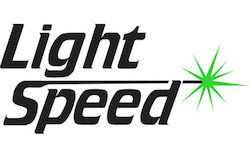
Fast, affordable Internet access for all.

In September, Reedsburg Utility Commission (RUC) in Wisconsin announced that they’re simplifying life for subscribers. They’ve eliminated service tiers and now everyone who signs up for the service receives affordable, symmetrical gigabit Internet access from their recently rebranded LightSpeed service.
Rebranding, Redefining Fast and Affordable
Back in May, RUC decided that they would renew their efforts at marketing by launching the new LightSpeed brand. At that time, they were already signing up new customers for the great gigabit deal, which translated into prices as low as $44.95 per month for 1,000 Megabits per second (Mbps or one gigabit) when purchased as part of a bundle. RUC also offers voice and video.
RUC has been offering Internet access to Reedsburg’s approximately 10,000 people since 2002. In 2014, they were the first in Wisconsin to offer gigabit connectivity. Over the past 16 years, they've expanded into different areas around the city in order to share the benefits of the network.
Growing That Gig
With the new gigabit offering to all, Reedsburg will venture out to two new areas. They received two grants from the state to expand to the Village of Spring Green and the Town of Delton.
 In Spring Green, located about 30 miles due south of Reedsburg, town officials have been working with the RUC to obtain the funding to bring high-quality Internet access to town. The grant will help fund the first phase of the project, which will bring better connectivity to several community anchor institutions, the school district, and multiple government facilities. In bringing LightSpeed to Spring Green, approximately more than 260 residential and 35 commercial premises will also have access to fiber.
In Spring Green, located about 30 miles due south of Reedsburg, town officials have been working with the RUC to obtain the funding to bring high-quality Internet access to town. The grant will help fund the first phase of the project, which will bring better connectivity to several community anchor institutions, the school district, and multiple government facilities. In bringing LightSpeed to Spring Green, approximately more than 260 residential and 35 commercial premises will also have access to fiber.
A few weeks ago, we wrote about one of the community meetings held by the Minnesota Public Utilities Commission (PUC) to address mounting frustrations over poor service from Frontier Communications. Subscribers at the meeting in Wyoming, Minnesota, complained of download speeds as slow as 0.05 Megabits per second (Mbps), outages that lasted for weeks, and unhelpful customer service representatives.
According to Minnesota Public Radio (MPR), the small town of Ceylon, Minnesota, has had to deal with even more insulting mistreatment at the hands of the company. Residents of Ceylon say that Frontier never actually finished installing its lines in the town. Instead, Frontier has left them lying in people’s yards and dangling from trees — for as long as three years, by one account.
Frontier’s “Corporate Indifference”
Internet access and telephone providers like Frontier usually bury cables underground or suspend them on utility poles to keep the infrastructure safe. In Ceylon, it appears that Frontier has taken a more lackadaisical approach, resulting in lines snaking through the grass, tied to trees, and even crossing over a propane tank. MPR notes that some people in the town have taken it upon themselves to move Frontier’s cables out of the way of harm, attaching them to posts and fences for fear of accidentally severing the connection.
Ceylon officials had previously requested that Frontier fix the problem, to no effect. At the PUC hearing in Slayton, Minnesota, City Councilmember John Gibeau said that the incomplete network installation represented Frontier’s “corporate indifference” to serving rural subscribers, MPR reports.
A representative from Frontier said the company would visit Ceylon to verify that the lines belong to them and to remedy the situation. But for now, Gibeau has a warning for Frontier: "You don't do that to my town and think you're going to get away with it."
While major media outlets cover news about California Governor Jerry Brown’s decision to sign the state’s network neutrality bill, we’re high-fiving his signature on AB 1999. On September 30th, Gov. Brown approved the bill that removes state restrictions limiting publicly owned options for rural Internet access. The change signifies what we hope to see more of - state action empowering local communities set on improving local connectivity.
We’ve been following the development of the bill, introduced by Assembly Member Ed Chau, since early this year when it began to make its way through committee. Christopher went to California in May to testify in support of the bill at a hearing of the Assembly Communications and Conveyance Committee.
Easing the Way for Rural Communities
AB 1999 focuses on the responsibilities and authority of community service districts (CSDs), created to provide necessary services. CSDs are independent local governments usually formed by residents in unincorporated areas for the purpose of providing the kinds of services city-dwellers often take for granted: water and wastewater management, trash collection, fire protection, etc. In keeping with the ability to raise funds for these services, CSDs have the authority to create enhanced infrastructure financing districts (EIFDs). CSDs are allowed to use EIFDs to fund development of Internet access infrastructure in the same way they would sewer infrastructure, or convert overhead utilities to underground, or other projects that deal with infrastructure and are in the public interest.
Prior to the adoption of AB 1999, however, a CSD would first have to engage in a process to determine that no person or entity was willing to provide Internet access before the CSD could offer it to premises. Additionally, if a private sector entity came along after the infrastructure was deployed and expressed a willingness to do so, the CSD had no choice by law but to sell or lease the infrastructure they had developed rather than operate it themselves.
With the passage of AB 1999, CSDs no longer need to adhere to those strict requirements.

Great Lakes Energy (GLE) in Michigan decided in late 2017 to approve a plan to incrementally deploy Fiber-to-the-Home (FTTH) to cooperative members, beginning with a pilot project in Petoskey. This week, Vice President of Communications, Marketing and Energy Optimization Shari Culver from GLE joins Christopher to talk about what could possibly become the largest FTTH project in the state.
GLE anticipates offering its symmetrical Truestream Internet access to members in the pilot area as early as the end of October. The planning process, however, has involved several feasibility studies and at least two years of planning in addition to several more years of contemplation. Shari explains how the region GLE serves covers many different types of geographies, subscriber income levels, and different levels of Internet access competition. Some folks have only dial-up, while others have the option of cable Internet access. One of the challenges GLE faces is educating potential subscribers about the differences between what they have now and the potential with Truestream.
She explains that the cooperative has decided to approach deployment with a flexible incremental approach, carefully examining demand as they deploy to determine where they go next across their service area. There’s a significant portion of seasonal homes in this northern section of the lower peninsula, and GLE sees that high-quality Internet access can help boost local economic development if those seasonal visitors have the ability to stay longer by working from the cabin.
For more on the project, check out our coverage.
This show is 23 minutes long and can be played on this page or via Apple Podcasts or the tool of your choice using this feed.
Transcript below.
We want your feedback and suggestions for the show-please e-mail us or leave a comment below.
Listen to other episodes here or view all episodes in our index. See other podcasts from the Institute for Local Self-Reliance here.
Thanks to Arne Huseby for the music. The song is Warm Duck Shuffle and is licensed under a Creative Commons Attribution (3.0) license.
According to the Federal Communications Commission (FCC), at least 35 percent of tribal residents do not have access to fixed broadband. In comparison, only 7.7 percent of all U.S. residents lack access to fixed broadband, defined as minimum speeds of 25 Megabits per second (Mbps) download and 3 Mbps upload.
However, a recent report from the Government Accountability Office (GAO) concludes that this disparity is probably even starker.
The report, prepared at the request of the U.S. Senate Committee on Indian Affairs, finds that the FCC’s broadband data is inadequate and inaccurate. As a result, the data overstate sbroadband availability nationwide, particularly in tribal areas. Additionally, the report notes that the FCC fails to engage tribes in the data collection process.
Bad data isn’t just a bureaucratic recordkeeping problem. Tribal communities can miss out on federal funding to improve connectivity in unserved and underserved areas if the FCC data shows that they already have access to broadband.
Reporting Methodology Overstates Access
For the most part, the FCC gets its information on fixed broadband availability through Form 477. Internet service providers (ISPs) submit the form twice a year, listing the census blocks they serve and the highest speeds they advertise.
This data collection methodology inherently exaggerates Internet access. Since ISPs report coverage by census block, an entire block is considered served even if the provider offers, or could offer, access to only one home.
 Many tribal lands are located in rural areas, the report notes, where large census blocks result in vast overstatements of broadband availability. Census blocks can also contain both tribal and non-tribal lands, further obscuring the extent to which tribal communities lack connectivity.
Many tribal lands are located in rural areas, the report notes, where large census blocks result in vast overstatements of broadband availability. Census blocks can also contain both tribal and non-tribal lands, further obscuring the extent to which tribal communities lack connectivity.
People in Arkansas who depend on Medicaid for healthcare typically don’t have the option to sign-up for affordable health insurance through their jobs. Sometimes they aren’t able to find full-time positions that offer healthcare or they don’t earn enough to afford the premiums in addition to covering life expenses for their families. With so many people offline, either because they can’t afford to pay for connectivity or because they live in areas where there is no connectivity, Arkansas seems like a poor choice for mandatory online reporting of anything, especially activity that dictates eligibility for Medicare.
State leaders didn’t see it that way, however, when they implemented the policy in June. Medicaid recipients who are able to work must now go online to report at least 80 hours per month of activity; if they fail to do so, they lose access to the state's expanded Medicaid program. The activity can include volunteer work, job training, or several other categories of activities. While the issue of attaching work requirements to Medicaid eligibility has already been deemed arbitrary and capricious by a U.S. District Court in Kentucky, the lack of Internet access appears to be contributing to Arkansas’s dubious efforts to trim its enrollment.
 Lack of Coverage Complicates
Lack of Coverage Complicates
In a state where at least 30 percent of the population has access to only one Internet service provider (ISP) and approximately 20 percent depend on their smart phones for Internet access, the only way to report the new work-related requirement is online. Under the guide of cost savings, the state has not established any other method for reporting for those who don’t have access to the Internet.
South Dakota has more cows than people — and if you live in a rural community in of the state, it’s possible that all those bovines may have better Internet access than you do.
South Dakota Dashboard recently released a report on rural Internet access in the state. It was commissioned by the South Dakota Telecommunications Association (SDTA), whose members include cooperative, municipal, and tribal providers. The report, Connecting South Dakota’s Future: A Report on the Deployment & Impact of Rural Broadband, found that rural connectivity in the state significantly exceeds national averages, proving that high-quality Internet access is possible even in the most rural areas.
Download the report for more details.
Summary of Findings
According to the report, more than three quarters of rural South Dakotans who subscribe to Internet access from SDTA members have access to speeds of 25 Megabits per second (Mbps) download and 3 Mbps upload, which are the federal minimums for broadband. Across the country, approximately 61 percent of rural residents have access to those speeds.
Furthermore, 65 percent of people who subscribe to Internet access from SDTA members receive service through Fiber-to-the-Premises (FTTP). In contrast, only around 40 percent of rural telecommunications company subscribers nationwide are connected via fast and reliable fiber optic lines.
This is all despite the fact that, with fewer than five residents per square mile, deploying fiber costs on average $3,571 per resident in the rural regions served by SDTA members versus about $26 per resident in the more densely populated Sioux Falls.
Fast Internet Speeds Nothing New for South Dakota
As a nation our goal is ubiquitous broadband coverage so every person, regardless of where they live, can obtain the fast, affordable, reliable Internet access necessary for modern times. For people in rural areas, where large national wireline providers don’t typically invest in the infrastructure for high-quality connectivity, satellite Internet access is often their only choice. In our Satellite Is Not Broadband fact sheet we address some of the reasons why depending on satellite Internet access to serve rural America is a mistake.
Download the Satellite Is Not Broadband fact sheet here.
Satellites are Cool, But...
It’s a marvel that science has found a way to deliver data in such a manner, but satellite Internet access is not the panacea for rural connectivity. The technology still faces many shortcomings. Rural residents that must depend on satellite for Internet access pay more and get less.
There’s a misguided faction of decision makers who try to describe satellite Internet access as “broadband,” which is patently incorrect. For those who have never used this type of Internet access, especially for an extended period of time, the realities don’t present themselves. This fact sheet lays out many of the reasons why, if we allow satellite Internet access to be the final technology of choice in rural areas, we cheat people who live there. In addition to the negative daily impacts, the incorrect perception of satellite Internet access effectiveness can end or reduce funding for rural wireline projects that will bring better connectivity.
Like our other fact sheets, Satellite Is Not Broadband is succinct, accessible, and a strong addition to your efforts to inform policy makers, legislators, and others with limited satellite Internet access experience.
If you’re looking to move to a community with a relaxing, rural lifestyle and quality Internet access, then Lyndon Township in Michigan may have just jumped to the top of your list. Now that the community has chosen an ISP to serve the community via its publicly owned infrastructure and established the cost of service, they're eager to start deployment.
Lyndon Township Board recently approved rates for their forthcoming fiber network, setting the price of symmetrical 1 Gigabit per second (Gbps) Internet speeds at a reasonable $69.95 per month. This is a nice reward for the township’s residents, who last year approved a tax increase to fund the construction of the network. The affordable residential gig brings Lyndon Township into the same price range as communities such as Lafayette, Louisiana; Westfield, Massachusetts; and Longmont, Colorado.
Local Support Founds, and Funds, the Network
Though only a 20-minute drive from the University of Michigan, a world class research institution, Lyndon Township residents are mostly stuck with expensive, slow, and unreliable satellite Internet service. Around 80 percent of the community doesn’t currently have access to broadband, which the FCC defines as a minimum of 25 Megabits per second (Mbps) download speed and 3 Mbps upload speed.
When attempts to get existing Internet service providers to expand into the community failed, the township decided to build its own Fiber-to-the-Home (FTTH) network. To fund the approximately $7 million network, residents approved a millage increase in 2017, with 66 percent of voters in support. The millage amounts to a property tax increase of $2.91 per $1,000 of taxable property.
Foresite Group has created a video that explains how open access networks can offer better connectivity, including the element of competition, for rural communities. In the video, they profile a strawberry farmer who now relies on expensive and unreliable satellite Internet access, but who needs broadband in order to improve his farming operation.
The short video explains the positives for the network owner, the potential subscribers, and ISPs that are interested in providing services to rural folks.
Check it out: